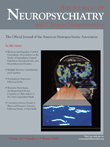Poststroke Hallucination Delusion Syndrome
To the Editor: Neurology and psychiatry are a continuum separated historically by Descartes. 1 Here we discuss a patient of poststroke hallucination delusion syndrome, a syndrome rare in literature. 2 , 3 The factors leading to atypical psychosis are not well understood. The role of the seizure following a stroke needs to be further ascertained.
Case Report
Mr. N, a 42-year-old right handed hypertensive male patient, presented with vivid hallucinations and delusions of paranoia and control of 2–3 months’ duration in 2004. He complained of an existing person for him who would “follow him trying to harm him,” “shout his name from his window,” and “see and smile from the roadside while chasing him.” His wife denied that such things were happening to him. His social and professional life was grossly affected. Neither he nor his relatives had a history of psychiatric disorder.
In 2002, he developed right-sided hemianopia with acute nonhemorrhagic infarct in posterior cerebral artery territory involving the left occipital lobe. In January 2003, he was admitted for slurring of speech and left arm weakness. Immediate magnetic resonance imaging (MRI) of the brain showed hyperacute non-hemorrhagic distal right middle cerebral artery territory infarct and chronic infarct in occipital lobes. He was sucessfully thrombolysed with complete clinical recovery.
Six months later, following thrombolysis, he developed partial seizure followed by generalized tonic clonic convulsions. His laboratory workup did not reveal any abnormality. Cardiac function was normal. Computerized tomography (CT) showed dilatation of the lateral ventricle. With no history (personal or family) of psychiatric illness, and with history of preceding stroke and later a seizure, lack of insight for his illness and persistent hallucinations and delusions, diagnosis of secondary hallucination delusion syndrome was made. He responded to high dose phenytoin sodium and sodium valproate.
Discussion
There is little description of atypical psychosis following stroke. 2 Why a few patients, and not many, develop schizophreniform disorders following stroke remains unanswered. 2
Here, our patient had strokes, seizure, and then acute onset hallucination and delusion. His lack of insight for his illness was remarkable. He had no history of psychiatric illness in the past or in family. His neuroradiological scans suggested ventricular dilatation.
It can be hypothesized that the stroke lesion site generates continuous electrical activity which is the organic substrate for his psychotic phenomenon. Our patient responded well to a high dose of phenytoin sodium, probably by modifying the underlying electrical activities, further suggesting the role of seizure activity in such disorders.
1 . Pert CB: Molecules of cognition: the science behind mind-body medicine. New York, Simon and Schuster, 1997Google Scholar
2 . Rabins PV, Starkstein SE, Robinson RG: Risk factors for developing atypical schizophreniform psychoses following stroke. J Neuropsychiatry 1991; 3:6–9Google Scholar
3 . Levine DN, Finkelstein S: Delayed psychoses after right temporoparietal stroke/trauma: relation to epilepsy. Neurology 1982; 32:267–273Google Scholar



